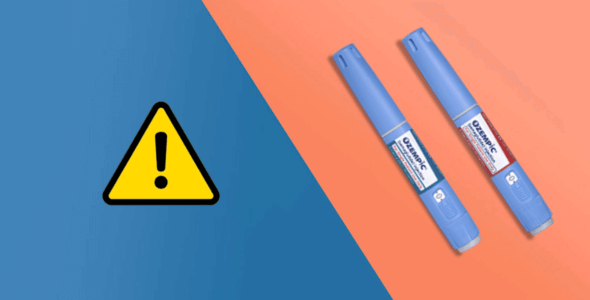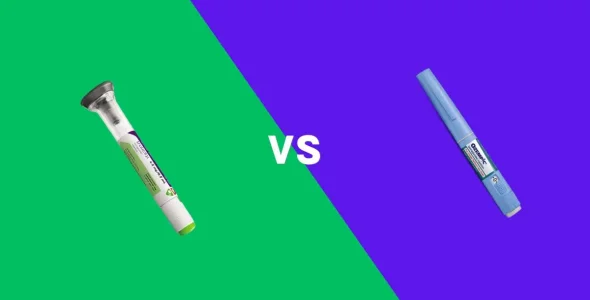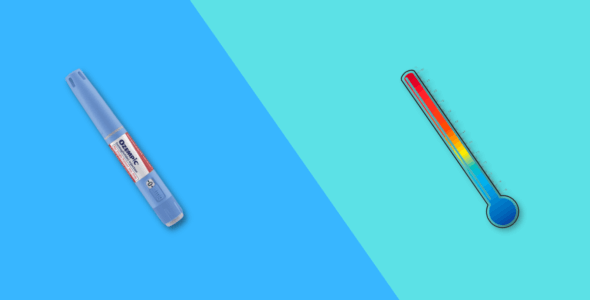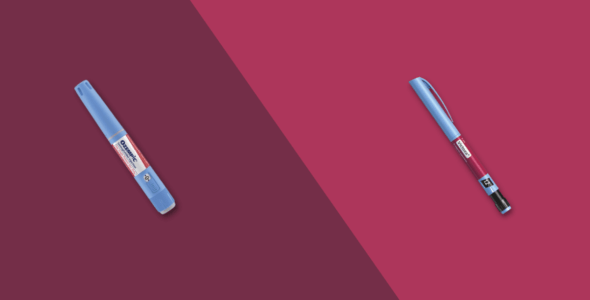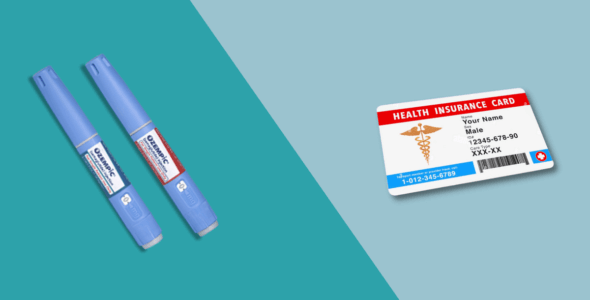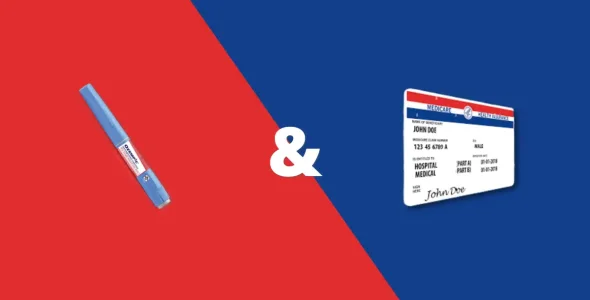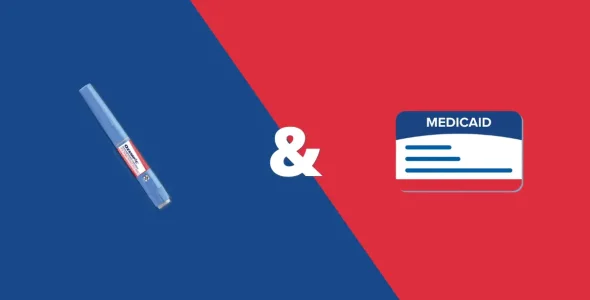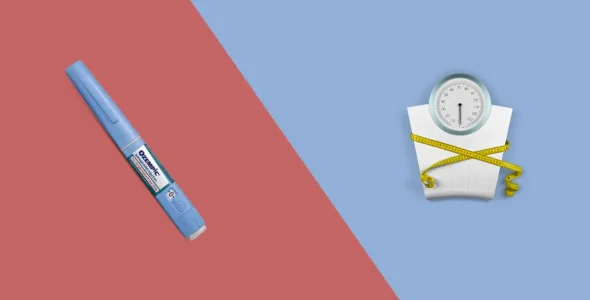How much is Ozempic without insurance? The Ultimate Guide
Paying for Ozempic out-of-pocket without insurance? You're not alone. Find out the real cost and strategies to save money.
Key highlights
- Ozempic (semaglutide) is a GLP-1 agonist approved to lower blood sugar levels in people with type 2 diabetes. It can be expensive without insurance.
- A 1-month supply of Ozempic can cost over $1,000 per month without insurance, but there are ways to reduce those costs.
- If you have insurance coverage that covers Ozempic, Ozempic could cost as little as $25 for a month’s supply.
- Many health insurance plans, like Medicare Advantage, Medicare Part D, and Medicaid, help pay for Ozempic if prescribed for type 2 diabetes.
- Insurance usually does not cover Ozempic if it is prescribed off-label for weight loss.
Ozempic (semaglutide) injection is a glucagon-like peptide-1 (GLP-1) receptor agonist used to lower blood sugar levels in people with type 2 diabetes and off-label for chronic weight management in people with overweight or obesity. It is also used to reduce the risk of major adverse cardiovascular events and prevent heart attacks in adults with cardiovascular disease.
The U.S. Food and Drug Administration (FDA) has also approved its use to prevent end-stage kidney disease in people with type 2 diabetes and chronic kidney disease.
A one-month supply of Ozempic can cost over $1,000 without insurance. That adds up to over $12,000 a year. Whether you’re using Ozempic for type 2 diabetes or weight loss (off-label), you’re probably looking for ways to save money.
If your doctor prescribes Ozempic, how much you pay will depend on factors such as whether you have insurance coverage for the medication or if you qualify for any discount programs from the manufacturer of Ozempic.
Don’t have insurance and need Ozempic? Find out the average cost, factors influencing the price, and effective strategies to save money on this medication.
How much does Ozempic cost without insurance? (2025)
No matter the dose, the list price of Ozempic is $997.58 for a 28-day supply without insurance, which is about $249.40 per week or $11,970.96 per year. The retail price you pay can vary depending on which pharmacy and location you purchase from.
The average retail price can range from $800-$1,000 per month. However, the actual cost to the patient can vary based on insurance coverage, discounts, and other factors.
There are no cheaper, generic versions of Ozempic available in the United States. If you don’t have insurance, ask your doctor about other diabetes medicines that cost less, like metformin, sulfonylureas, meglitinides, and alpha-glucosidase inhibitors. These medications are FDA-approved to help lower blood glucose levels, but they may not work as effectively as Ozempic.
Insurance covers Ozempic for type 2 diabetes because it’s FDA-approved for that use. Weight loss, however, is not an FDA-approved indication for Ozempic, so insurance typically doesn’t cover it for weight loss. If you are using the medication for weight loss, consider Wegovy, another GLP-1 medication with the same active ingredient, semaglutide, which is FDA-approved for chronic weight management.
Here’s a price comparison of Ozempic using coupons from different pharmacies
| Pharmacy | Avg. Retail Price of Ozempic | Price with GoodRx coupon | Price with SingleCare coupon |
|---|---|---|---|
| Walgreens | $1,154–1,162 | $1,002 (savings of $152–160 or 13–14%) | $1,020 (savings of $134–142 or 12%) |
| CVS | $1,135–1,143 | $1,003 (savings of $132–140 or 12%) | $870 (savings of $265–273 or 23–24%) |
| Walmart | $1,163–1,170 | $1,014 (savings of $149–156 or 13%) | $851 (savings of $312–319 or 27%) |
| Rite Aid | $1,257–1,267 | $950 (savings of $307–317 or 24–25%) | $951 (savings of $306–316 or 24–25%) |
Why is Ozempic so expensive?
The high cost of Ozempic is driven by the lack of generic drug competition, the complexity of the U.S. drug pricing system, and the investments made by Novo Nordisk in R&D and manufacturing.
Pharmaceutical patents and no generics
Ozempic is patented, so no one else can make and sell a generic in the United States. The patent is valid until 2031, so Novo Nordisk has exclusive rights to make and sell Ozempic until the patent expires. Without generics, there’s no competition to drive the price down, so the price remains high for consumers.
U.S. healthcare system and drug pricing
The U.S. healthcare and drug pricing system is complicated with multiple layers, like insurance coverage, Pharmacy Benefit Managers (PBMs), and drug manufacturing costs. The cost of medications is influenced by the negotiations between pharmaceutical companies, insurance providers, and PBMs, each trying to get the best deal. These layers of complexity can result in higher out-of-pocket costs for consumers even if they have insurance.
Manufacturing and research & development costs
Novo Nordisk invests heavily in manufacturing and research & development (R&D) to make new and innovative medications like Ozempic. These costs include clinical trials, regulatory approvals, and quality control. R&D is high because developing effective and safe medications takes years and a lot of resources.
Role of pharmacy benefit managers (PBMs)
PBMs are the middlemen between insurers, drug manufacturers, and pharmacies. Even for cash-paying customers, PBMs can influence the final price at the pharmacy by negotiating discounts with drug manufacturers. These negotiated rates affect what consumers pay, even if they’re not using insurance to cover the cost. In some cases, PBMs may have agreements that make Ozempic more expensive for consumers, depending on how the medication is priced and negotiated.
Is Ozempic covered by insurance?
Many insurance plans, including Medicare and Medicaid, will help pay for Ozempic if it’s prescribed for type 2 diabetes, but not for weight loss. How much you will pay depends on your copay and if you’ve met your deductible.
If your insurance doesn’t cover Ozempic, start by reading the “Indications” section on the drug information sheet. Ozempic is approved for type 2 diabetes, so insurance won’t pay for it if it’s prescribed for weight loss. Next, talk to your insurance company or pharmacist. For expensive drugs like Ozempic, the insurance company may need prior authorization, which means your doctor has to fill out forms to explain why you need it.
Some insurance companies use step therapy before they approve Ozempic. This means your doctor has to attest that the patient has tried other medications first, for a set amount of time, before the insurance provider will cover Ozempic. Your doctor can check the specific step therapy rules for your insurance plan.
How to get Ozempic cheaper without insurance?
Ozempic can cost over $12,000 a year, which makes it hard to afford without prescription drug insurance. There are several ways to save on the medication, which we explain below.
Ozempic Savings Card
Ozempic can be expensive, especially if your insurance doesn’t cover it. Novo Nordisk offers an Ozempic Savings Card to help lower the cost, but you need to have commercial insurance that covers part of Ozempic and a Type 2 diabetes diagnosis to qualify. You could pay as little as $25 for a 1-month, 2-month prescription, or 3-month supply for up to 48 months.
If you qualify, the savings card can help you save up to:
- $100 on a 1-month prescription
- $200 on a 2-month prescription
- $300 on a 3-month prescription.
Individuals with government-sponsored insurance like Medicaid, Medicare, VA, TRICARE, or similar plans can’t use the Ozempic Savings Card. If you have employer insurance but it doesn’t cover Ozempic, you also can’t use the card. It’s only for people with private or commercial insurance that covers Ozempic.
To apply for the Ozempic Savings Card and check if you qualify, visit the Novo Nordisk website. If you already paid for your Ozempic before you found out about the coupon, you might be able to get some of your money back using Novo Nordisk’s Savings Offer reimbursement form, if you qualify.
NovoCare Pharmacy
If you have been prescribed Ozempic and are paying out-of-pocket, you can purchase the medication for a discounted price of $499 per month (28-day supply) through NovoCare Pharmacy. This direct-to-consumer service is provided by Novo Nordisk and includes free shipping.
Novo Nordisk Patient Assistance Program (PAP)
Drug manufacturers offer patient assistance programs to help low-income, uninsured, and underinsured individuals access their medication for free.
The NovoCare Patient Assistance Program (PAP) helps low-income individuals who are uninsured or underinsured and cannot afford their medications. If you qualify, the program will provide you with free Ozempic or Rybelsus. To apply, you need to meet certain income and eligibility requirements:
- You are a U.S. citizen or resident
- Your total household income is at or below 400% of the federal poverty level (FPL)
- You have a prescription that meets the FDA-approved labeling
- You are uninsured or have Medicare with no other prescription drug coverage
- You do not have private or commercial insurance
- You are not enrolled or qualify for any federal, state, or government programs that provide prescription benefits, such as Medicaid, Low Income Subsidy (LIS), or Veterans Affairs (VA) benefits.
You can visit the NovoCare website to check if you qualify and start the application process, or call 1-866-310-7549.
If you’re eligible, there may be income limits, so having proof of income documents like recent pay stubs or tax returns ready can help speed up the process. Also, keep in mind that patient assistance programs usually only cover the medication when it’s prescribed for its approved use, so using it for weight loss without type 2 diabetes may not qualify.
Pharmacy discount cards
Pharmacy discount programs like GoodRx and SingleCare can help lower the cost of medications, including Ozempic, if you’re paying out of pocket.
- GoodRx provides discount coupons that can be used at most major pharmacies, including Walgreens, CVS, and Walmart. For example, a 30-day supply of Ozempic might cost around $1,000 without insurance, but when using a GoodRx coupon, the price could drop to about $965 at participating pharmacies.
- SingleCare also offers discount cards that can be used at many pharmacies. You can get Ozempic for as low as $822 per month when using a SingleCare discount card.
- RxSaver offers prescription discount cards that can help you save up to 80% on medications, including Ozempic, at participating pharmacies like CVS, Walgreens, and Walmart. You can access these discounts instantly through their website or mobile app, with no membership or sign-up required.
Mail-order pharmacies
Mail-order pharmacies can offer lower prices because they have lower overhead since they don’t need physical stores. They often offer 90-day supplies, which can be cheaper per dose. Additionally, mail-order pharmacies may have special pricing agreements with insurance plans or work directly with drug manufacturers, cutting out extra costs. If you’re considering using one, check with your insurance provider to see if it’s covered and compare prices with your local pharmacy.
90-day supplies
Sometimes, getting a 90-day supply of Ozempic can be cheaper than getting three 30-day supplies. Ask your pharmacist to compare the prices. If the 90-day option saves you money and you can afford it, it might be a better choice.
Flexible Spending Accounts (FSAs) and Health Savings Accounts (HSAs)
If you have a health savings account (HSA) or flexible savings account (FSA), you can use that money to pay for your Ozempic medication. It won’t lower the price at the pharmacy, but it can save you money over time because you’re using pre-tax dollars.
Cheaper alternatives to Ozempic
Ozempic is part of a new and innovative class of prescription medications called GLP-1 agonists, which includes other drugs with similar ingredients. Switching to a different GLP-1 drug might help you save money.
It’s important to remember that switching medications should only be done under the guidance of a healthcare professional. Always talk to your doctor before making any changes to your treatment or before starting any supplements.
Generic semaglutide
As of April 2025, there is no FDA-approved generic version of semaglutide (the active ingredient in Ozempic and Wegovy) available in the United States. Novo Nordisk’s patents on semaglutide expire in December 2031, which is the earliest a generic could be marketed in the U.S.
Wegovy
Like Ozempic, Wegovy is a once-a-week injectable medication made by Novo Nordisk. However, it has a higher dose (2.4 mg) of semaglutide and is FDA-approved for weight loss in people who are overweight or obese. Wegovy is also approved to help lower the risk of major heart problems, like a stroke or heart attack, in people with obesity or overweight and heart disease. Like Ozempic, it should be used along with lifestyle changes, such as a healthy diet and exercise.
Wegovy is more expensive than Ozempic, costing $1,349.02 for a 28-day supply. However, you can also get Wegovy without insurance for $499 through NovoCare, the manufacturer’s direct-to-consumer pharmacy.
Rybelsus
Rybelsus is an oral tablet that is FDA-approved for lowering blood glucose levels in adults with type 2 diabetes and may also help with weight loss. Although it’s not FDA-approved to reduce the risk of heart attack or stroke, studies suggest it’s safe for people with heart disease.
The common side effects of Rybelsus are nausea, vomiting, diarrhea, constipation, and abdominal pain. Although rare, some people taking Rybelsus may experience a severe allergic reaction, kidney or gall bladder problems, low blood sugar (hypoglycemia), pancreatitis (inflammation of the pancreas), and diabetic retinopathy.
Without insurance, a 30-day supply of Rybelsus costs about $997.58. If you’re eligible, you could pay $10 for Rybelsus (1-month supply) with a copay savings card from the manufacturer. The Rybelsus Savings Card program is limited to those with commercial insurance.
Mounjaro and Zepbound (tirzepatide)
Tirzepatide is the active ingredient in Mounjaro and Zepbound. Both are once-weekly injectable medications with the same dosages, but they are approved for different indications.
Like Wegovy, Zepbound is FDA-approved for weight management in adults with obesity (BMI of 30 or higher) or overweight (BMI of 27 or higher) and related health issues like high blood pressure or diabetes. Mounjaro is FDA-approved for controlling blood sugar in adults with type 2 diabetes, like Ozempic and Rybelsus.
Mounjaro costs $1,069.08 for a 28-day supply, which is about $267.27 per week or $12,828.96 per year. Zepbound is slightly cheaper at about $1,059.87 for a 28-day supply, or $264.97 per week, and $12,718.44 per year.
Eli Lilly, the manufacturer of Mounjaro and Zepbound, offers Savings Cards for both drugs. If you have commercial drug insurance, you may be eligible for the savings card program, even if your insurance doesn’t cover the medication (other conditions may apply).
- Mounjaro Savings Card: If your commercial insurance covers Mounjaro, you can pay as little as $25 for a 1-month, 2-month, or 3-month prescription. If you have commercial insurance without coverage for Mounjaro, the card can save you up to $463 for a 1-month prescription.
- Zepbound Savings Card: If your commercial insurance covers Zepbound, you can pay as little as $25 for a 1-month, 2-month, or 3-month prescription. If you have commercial insurance without coverage for Zepbound, the card can save you up to $469 for a 1-month prescription.
You can also obtain single-dose Zepbound vials directly from LillyDirect, which costs $399/month for the 2.5 mg vial and $499/month for the 5 mg, 7.5 mg and 10 mg vials.
Mounjaro and Zepbound are not currently included in Eli Lilly’s patient assistance program.
Saxenda and Victoza (liraglutide)
Liraglutide, sold under the brand names Victoza and Saxenda, treats type 2 diabetes and obesity.
Approved in 2010, Saxenda (liraglutide) was the first GLP-1 medication approved for weight loss in adults with obesity or overweight with at least one weight-related health issue. It is also approved for children aged 12 and older with obesity. It’s made by the same company as Wegovy, Novo Nordisk.
Saxenda has the same list price as Wegovy, costing about $1,349.02 without insurance. However, the Saxenda Savings Card offered by Novo Nordisk can bring the cost down to as low as $25 for those with commercial insurance.
Like Wegovy, insurance plans usually won’t cover Saxenda without prior authorization. If you have type 2 diabetes, your insurance provider is more likely to cover Victoza, which contains the same active ingredient as Saxenda, liraglutide.
Victoza (liraglutide) is another injectable GLP-1 agonist that lowers blood sugar in adults with type 2 diabetes with known heart disease, but it needs to be injected once a day instead of once a week because it doesn’t stay in the body as long as Mounjaro and other alternatives. The FDA approved liraglutide, the first generic of a once-daily GLP-1 injection, in December 2024.
Unlike Mounjaro, Victoza has proven heart protection benefits. It’s approved for people aged 10 and older. However, Victoza has fewer side effects compared to Mounjaro.
Novo Nordisk offers savings cards for Saxenda and Victoza. If you have commercial drug insurance or are uninsured, you may be eligible for the savings card program, even if your insurance doesn’t cover the medication.
- Saxenda Savings Card: If your commercial insurance covers Saxenda, you can pay as little as $25 for a 1-month supply of Saxenda with a maximum savings of $200 per month. If you have commercial insurance without coverage for Saxenda or are uninsured, you can save up to $200 per month.
- Victoza Savings Card: If your commercial insurance covers Victoza, you can pay as little as $25 for a 1-month supply of Victoza with a maximum savings of $100 per month. If you have commercial insurance without coverage for Victoza or are uninsured, you can save up to $200 per month.
If you don’t have insurance or have limited coverage and have type 2 diabetes, you might be able to get Victoza for free through the Novo Nordisk patient assistance program if you meet certain income and insurance criteria.
There is a generic liraglutide available, which provides additional savings for those taking this medication.
Trulicity (dulaglutide)
Trulicity (dulaglutide) is a once-weekly subcutaneous injectable GLP-1 agonist that helps control blood sugar levels and reduce cardiovascular risk in adults and children from 10 years of age with type 2 diabetes. Some people may also experience weight loss with it.
Without insurance, a month’s supply is around $800-$900, but with insurance, it can be much lower, depending on your plan.
The Trulicity Savings Card program can reduce the cost of Trulicity to as low as $25 per month if you have commercial insurance that covers Trulicity.
Insurance coverage for Trulicity may vary, and some plans may cover it for diabetes but not for weight loss. If you can’t afford it, the manufacturer has assistance programs that may help reduce the cost for eligible patients. Check with your insurance and your healthcare team for details.
Individuals who are uninsured or underinsured and meet the specified income and insurance eligibility requirements may be eligible to receive Trulicity at no cost through the LillyCares Patient Assistance Program.
Phentermine/topiramate (Qsymia)
Topiramate is a once-daily medication used to treat seizures and prevent migraines. Phentermine is an appetite suppressant that works by increasing levels of norepinephrine in the brain, which signals a decrease in hunger. It can also be used for weight loss in combination with other drugs. On average, Qsymia costs $149 per month without insurance.
Metformin
Metformin (Glumetza and Fortamet) is a pill used to treat type 2 diabetes by helping control blood sugar levels. On average, metformin costs $35 per month without insurance.
Naltrexone/bupropion (Contrave)
This weight loss drug is taken twice daily and used to help with weight loss by reducing hunger and cravings. It combines two drugs, naltrexone and bupropion, to affect brain chemicals that control hunger. On average, Contrave costs $694–817 per month without insurance.
Here’s a comparison of prices of several alternatives to Ozempic:
| Medication | Estimated Retail Price for Monthly Supply | FDA-Approved Indications |
|---|---|---|
| Ozempic (semaglutide) | $997.58 | Type 2 diabetes; cardiovascular risk reduction in people with type 2 diabetes and heart disease; kidney disease risk reduction in people with type 2 diabetes and chronic kidney disease |
| Wegovy (semaglutide) | $1,349.02 or $499 (through NovoCare online) | Weight loss; cardiovascular risk reduction in people with heart disease and obesity or overweight |
| Rybelsus (semaglutide) | $997.58 | Type 2 diabetes |
| Zepbound (tirzepatide) | $1,086.37 (pen); Starting at $399 for vials | Weight loss; obstructive sleep apnea |
| Mounjaro (tirzepatide) | $1,079.77 | Type 2 diabetes |
| Saxenda (liraglutide) | $1,349.02 | Weight loss |
| Victoza (liraglutide) | $543.51–$815.27 | Type 2 diabetes; cardiovascular risk reduction in people with type 2 diabetes and heart disease |
| Metformin (metformin) | $4–$16 | Type 2 diabetes |
Can you get Ozempic for free or at a lower cost?
Yes, in some cases, you can get Ozempic for free. Novo Nordisk has a patient assistance program that provides Ozempic at no cost. To qualify, you must be a U.S. citizen or legal resident with a household income at or below 400% of the federal poverty level. You also can’t have insurance other than Medicare, including Medicaid or other government programs like VA benefits. You will also need to have a valid prescription for an FDA-approved indication.
You can check if you qualify using the federal poverty guidelines. After you apply for the program, you should hear back from Novo Nordisk in about two weeks.
Participating in clinical trials is another way to receive Ozempic at no cost. These trials are research studies that test new treatments. If you qualify and are selected, you may receive the medication and related care for free. To find ongoing clinical trials, you can visit ClinicalTrials.gov and search for studies involving Ozempic or semaglutide.
Some state and county health programs offer assistance with medications like Ozempic for uninsured or low-income individuals. However, coverage varies by location and the specific program. For instance, some states provide Medicaid coverage for Ozempic when prescribed for type 2 diabetes, while others may not cover it for weight loss. It’s important to check with your local health department or Medicaid office to understand the options available in your area.
Advocacy and support organizations
Several U.S.-based patient advocacy organizations support people with diabetes and obesity, offering resources and financial aid information. Here are a few:
American Diabetes Association (ADA)
The ADA has resources for managing diabetes and information on financial assistance programs and medication access. They also advocate for affordable healthcare and medication prices.
JDRF (Juvenile Diabetes Research Foundation)
JDRF is focused on Type 1 diabetes but has information on managing the disease and support, including financial aid options.
Obesity Action Coalition (OAC)
The OAC supports people with obesity. They have educational resources, advocacy, and information on affordable treatments.
The Partnership for Prescription Assistance (PPA)
PPA helps patients get free or low-cost medications through various programs, including those for diabetes and weight loss medications.
NeedyMeds
NeedyMeds has a database of patient assistance programs, including those for diabetes medications like Ozempic.
Talk to your healthcare provider openly and honestly about the cost of Ozempic. They can help you find alternatives, and financial assistance programs, or work with you to develop a treatment plan that fits your budget. By discussing your concerns and options, you’ll get the best care while managing costs.
FAQs
Does Medicaid cover Ozempic?
Some Medicaid plans cover Ozempic and other GLP-1 drugs. Check your state’s Medicaid website to see if Ozempic is covered by your plan. You have to meet certain requirements (like having a low income) to qualify for Medicaid. Some medications may require prior approval from the insurance company before they are covered.
Does Medicare cover Ozempic?
Most Medicare prescription drug plans (including Medicare Advantage and Medicare Part D) cover Ozempic if it’s prescribed for certain conditions like type 2 diabetes. The price you pay for Ozempic will depend on your copay and if you’ve met your deductible.
Can I use the Ozempic coupon without insurance?
No, you can’t use the manufacturer’s Ozempic Savings Card coupon without insurance. This coupon is for people with commercial or private insurance that partially covers Ozempic. It’s not valid for the uninsured or those with government-issued insurance like Medicaid or Medicare. You can use coupons from websites like GoodRx and SingleCare without insurance.
Are compounding pharmacies safe for Ozempic alternatives?
Compounding pharmacies can make Ozempic alternatives. Keep in mind that compounded medications are not reviewed by the FDA for safety and effectiveness. Talk to your doctor before using any compounded alternatives.
Conclusion
Uninsured individuals in the U.S. face high costs for Ozempic, often over $1,000 for a month’s supply. Without insurance or financial assistance programs, it can be challenging to afford.
Some insurance plans will cover part or all of the cost of the medication, depending on your coverage and why it’s prescribed.
Uninsured individuals should proactively research all savings options, including manufacturer savings cards and patient assistance programs. Alternatively, you can also talk to your healthcare team to explore affordable alternatives including other GLP-1 drugs and generic drugs.


